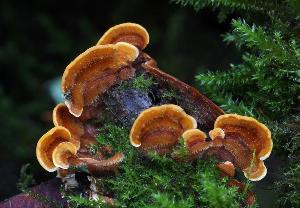
This genome was sequenced as a part of the large-scale multi-genome JGI CSP Saprotrophic Agaricomycotina Project (SAP), which focuses on the diversity and evolution of decay mechanisms, organismal phylogenetic relationships, and developmental evolution. A large collaborative effort led by PI of this project, David Hibbett (Clark University) aims for master publication(s) of the SAP data analysis. Researchers who wish to publish analyses using data from unpublished SAP genomes are respectfully required to contact the PI and JGI to avoid potential conflicts on data use and coordinate other publications with the SAP master paper(s).
Stereum hirsutum (Willd.) Pers. is a Basidiomycete that produces persistent, resupinate, effused-reflexed or even pileate basidiocarps with a smooth or tuberculate hymenophore. Basidiocarps of the species are usually collected on dead parts of living hardwood trees or occasionally conifers or even on branches fallen on the ground. The species has a worldwide distribution and belongs to the pioneer wood-rotting species to colonize wood. Initially placed in the artificial group of corticioid fungi, recent phylogenetic studies place Stereum hirsutum in the Russuloid clade. The placement of the species in the Russuloid clade makes it an appropriate candidate for comparative studies with Heterobasidion annosum (Fr.) Bref., a strong conifer pathogen placed also in the Russuloid clade, which was recently sequenced by the Joint Genome Institute. Furthermore the species produces a white type rot but no details are known about the gene content related to the white rot biochemistry for the species. There are studies supporting the presence of manganese peroxidases and laccases, while it has been shown that the species can bleach kraft lignin. The genome of Stereum hirsutum will increase our knowledge about the white rot mechanism of the wood rotting species of the clade. Finally it will give us the opportunity to compare the wood rot biochemistry with other major clades of the Basidiomycetes such us the Polyporales and Agaricales.
Genome Reference(s)
Floudas D, Binder M, Riley R, Barry K, Blanchette RA, Henrissat B, Martínez AT, Otillar R, Spatafora JW, Yadav JS, Aerts A, Benoit I, Boyd A, Carlson A, Copeland A, Coutinho PM, de Vries RP, Ferreira P, Findley K, Foster B, Gaskell J, Glotzer D, Górecki P, Heitman J, Hesse C, Hori C, Igarashi K, Jurgens JA, Kallen N, Kersten P, Kohler A, Kües U, Kumar TK, Kuo A, LaButti K, Larrondo LF, Lindquist E, Ling A, Lombard V, Lucas S, Lundell T, Martin R, McLaughlin DJ, Morgenstern I, Morin E, Murat C, Nagy LG, Nolan M, Ohm RA, Patyshakuliyeva A, Rokas A, Ruiz-Dueñas FJ, Sabat G, Salamov A, Samejima M, Schmutz J, Slot JC, St John F, Stenlid J, Sun H, Sun S, Syed K, Tsang A, Wiebenga A, Young D, Pisabarro A, Eastwood DC, Martin F, Cullen D, Grigoriev IV, Hibbett DS
The Paleozoic origin of enzymatic lignin decomposition reconstructed from 31 fungal genomes.
Science. 2012 Jun 29;336(6089):1715-9. doi: 10.1126/science.1221748
